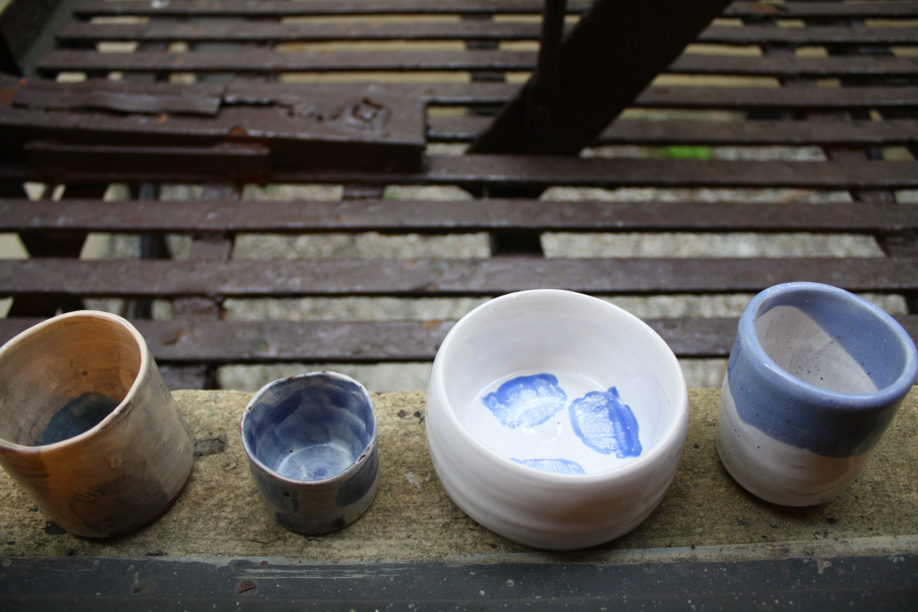April 7, 2018
Jersey City, New Jersey
I pulled up for my first ceramics class on a cloudy and bright Saturday morning. The brick building was small and compact compared to the surrounding dilapidated buildings. The website claimed it used to be a carriage-house for a fruit company. No signage, but orange numbers told me I was at the right location. To my left was a small patch of yellow daffodils. I opened the door, and a wind chime welcomed me as I climbed up creaky, narrow wooden stairs to a studio loft. The open room had soft natural lighting. Five other people were already there.
The instructor, Frank, was soft-spoken and mirrored our awkward energy as he gave a run-through of classroom etiquette and rules. He was in his sixties. His feathered white hair was parted to the right. He was wearing a camo-patterned t-shirt neatly tucked into blue jeans and accessorized with a brown leather belt. His clean gray sneakers had bright orange laces.
First, he introduced us to a 25-pound brick of clay. We cut out 2-pound sections. He taught us how to wedge, a repetitive and tedious kneading process that was meant to remove any air bubbles. Preparing the clay makes it pliable and less likely to explode when baking in the kiln. We learned how to cycle through the clay by kneading repeatedly until it looked like a pain au chocolat. The clay was cool. It fit snug against the webbing between my thumb and index finger as I pressed into the croissant. Frank instructed us to repeat this 1000 times. I managed about six.
“Try to dispel any pottery images from romance films in your head,” Frank prefaced before starting to demonstrate the next stage — centering. The wheel spun and the mound wobbled. The goal of centering is to contain the wobble until the wobbling stops. I added water and the clay glided between my hands.
Frank said the formula for wheel-thrown ceramics is balancing speed, pressure and moisture. I tried to harness the wobble but I was too timid. I didn’t want to look like my neighbor. Her hands and wheel were a slaughterhouse. It was her first time. She was disheveled but delighted in the gray matter splattered all over her arms. I was both embarrassed for her and jealous. I couldn’t my clay to center quite right and my face felt very hot. Veronica, Frank’s assistant came to my rescue. Clay has started to splash on my clothes. I liked it, though.
Frank was teaching us how to pull a cylinder. Pulling is taking clay from the base and nudging it upwards to create height. This is a slow and a deliberate process. “Don’t get hypnotized by the wheel,” he said. “That’s when you mess up.” The spiral is seductive. I felt helpless and stared at the spinning wet mass. I wanted my clay to turn into a cylinder — I fantasized about it becoming something functional, maybe a kitchen crock. My wheel kept spinning and spinning. My clay barely grew taller.
“Try not to crash and burn,” Frank said as he walked us through the hardest step, which is to play with shape. I think he was instructing us to experiment, but in typical fashion, I took him too seriously. I didn’t want to break any rules, but I don’t know the rules. I don’t remember what it feels like to play.
“What did you do?” Frank said with exaggerated annoyance to a student. She added too much water and was re-assigned a new lump of clay. My lump was still a lump.
I asked a lot of questions. “Where does my palm go?” “How do I know the wheel isn’t moving too fast?” “Where do I start pulling?” “What is this stage called again?” A floppy cylinder spun on the wheel. I was unable to take command.
The class wound down. Frank told us not to save our pieces. “Collapse them and lay the wet clay out to dry. You can use it next week.”
I took a wire-cutter and ruefully ran it under the wet cylinder to detach my severe masterpiece from the wheel. I carefully held its shape and brought it to the dry station, to say goodbye.
I left the studio, with dried clay on my pants and sweater. I thought I’d probably come back.
 Caroline Lee
Caroline Lee




